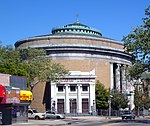University High School (New Jersey)
University High School of Humanities (usually University High School) is a six-year public high school serving students in seventh through twelfth grades in Newark, in Essex County, New Jersey, United States, as part of the Newark Public Schools. Originally created as a program called "School Within a School" at Malcolm X Shabazz High School, University High School became a standalone school in 1977. It moved into the old Clinton Place Junior High building in 1982.As of the 2021–22 school year, the school had an enrollment of 464 students and 41.0 classroom teachers (on an FTE basis), for a student–teacher ratio of 11.3:1. There were 354 students (76.3% of enrollment) eligible for free lunch and 38 (8.2% of students) eligible for reduced-cost lunch.
Excerpt from the Wikipedia article University High School (New Jersey) (License: CC BY-SA 3.0, Authors).University High School (New Jersey)
Millington Avenue, Newark
Geographical coordinates (GPS) Address External links Nearby Places Show on map
Geographical coordinates (GPS)
| Latitude | Longitude |
|---|---|
| N 40.72104 ° | E -74.210697 ° |
Address
University High School
Millington Avenue
07108 Newark
New Jersey, United States
Open on Google Maps



